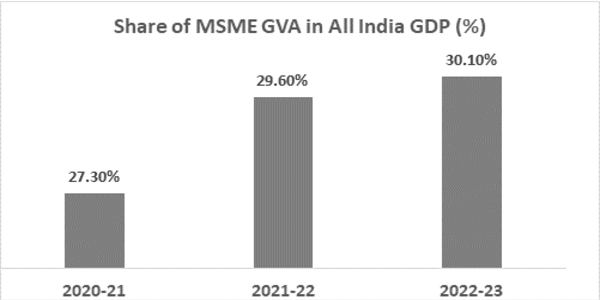24 December 2024 : PIB Summary For UPSC
(Source – https://pib.gov.in/PressReleseDetail.aspx?PRID=2087361®=3&lang=1 )
| Topic: GS3 – Indian Economy |
| Context |
|
MSMEs’ Contribution to India’s Export Growth
- MSME exports rose significantly from ₹3.95 lakh crore in 2020-21 to ₹12.39 lakh crore in 2024-25.
- The number of exporting MSMEs increased from 52,849 in 2020-21 to 1,73,350 in 2024-25.
- MSMEs contributed 45.73% to India’s exports in 2023-24, which further increased to 45.79% by May 2024.
MSMEs’ Role in India’s GDP
- The Gross Value Added (GVA) by MSMEs in GDP grew from 29.7% in 2017-18 to 30.1% in 2022-23.
- Even during the COVID-19 pandemic, MSMEs maintained a significant GDP contribution of 27.3% in 2020-21 and rebounded to 29.6% in 2021-22.
- This demonstrates MSMEs’ resilience and pivotal role in India’s economic stability.

| Growth and Upgradation of Enterprises |
● MSMEs are classified into Micro, Small, and Medium Enterprises based on investment and turnover criteria revised on July 1, 2020.
● From 2020-21 to 2021-22, 714 Micro enterprises and 3,701 Small enterprises scaled up to Medium. ● The trend grew stronger in 2023-24 to 2024-25, with 2,372 Micro enterprises and 17,745 Small enterprises upgrading to Medium enterprises. |
Significance of MSMEs for Economic Development
- MSMEs are instrumental in employment generation, entrepreneurship promotion, and inclusive growth.
- The sector fosters innovation, supports export competitiveness, and strengthens India’s position as a global economic leader.
- By creating employment opportunities and driving economic development, MSMEs serve as the backbone of India’s economy.
| PYQ: Faster economic growth requires increased share of the manufacturing sector in GDP, particularly of MSMEs. Comment on the present policies of the Government in this regard. (150 words/10m) (UPSC CSE (M) GS-3 2023) |
| Practice Question: Examine the role of Micro, Small, and Medium Enterprises (MSMEs) in boosting India’s exports and GDP. How can policy interventions and technological advancements strengthen the sector’s global competitiveness and resilience? (150 Words /10 marks) |
2. National Workshop on PESA Act to be Held in Ranchi, Jharkhand on 24th December 2024
(Source – https://pib.gov.in/PressReleseDetail.aspx?PRID=2087187®=3&lang=1 )
| Context |
|
Introduction:
- The Panchayats (Extension to Scheduled Areas) Act, 1996, or PESA, was enacted to ensure self-governance through Gram Sabhas for people living in the Scheduled Areas of India.
Key Features of PESA:
- Empowerment of Gram Sabhas:
- Grants Gram Sabhas the power over local plans and resources, including the authority to manage minor forest produce.
- Requires mandatory consultation with Gram Sabhas in matters of land acquisition, resettlement, and rehabilitation.
- Planning and Development:
- Gram Sabhas are responsible for approving village development plans.
- They identify beneficiaries for poverty alleviation programs.
- Control over Resources:
- Gram Sabhas have the right to control and manage local markets.
- They regulate money lending to prevent exploitation of tribal communities by money lenders.
- Social Justice:
- Gram Sabhas play a role in resolving local disputes.
- They have the power to enforce prohibition or regulate the sale of liquor within their areas.
Applicability
- Applies to the Fifth Schedule areas across 10 states: Andhra Pradesh, Chhattisgarh, Gujarat, Himachal Pradesh, Jharkhand, Madhya Pradesh, Maharashtra, Odisha, Rajasthan, and Telangana.
Significance of PESA:
- Tribal Self-Rule: PESA aims to empower tribal communities by recognizing their traditional rights and enabling them to participate in decision-making processes that affect their lives.
- Preservation of Culture: The Act helps protect the cultural identity of tribal communities by recognizing their customary laws and practices.
- Sustainable Development: By granting control over natural resources to Gram Sabhas, PESA promotes sustainable and equitable development in Scheduled Areas.
Challenges and Implementation:
- Lack of Awareness: Many tribal communities are not fully aware of their rights under PESA.
- State-level Dilution: Some states have enacted laws that dilute the provisions of PESA, limiting its effectiveness.
- Bureaucratic Hurdles: Bureaucratic resistance and lack of political will have also hindered the implementation of PESA in some areas.
| PYQ: Article 244 of Indian Constitution relates to Administration of Scheduled areas and tribal areas. Analyze the impact of non-implementation of the provisions of fifth schedule on the growth of Left Wing Extremism. (200 words/10m) (UPSC CSE (M) GS-3 2013) |
| Practice Question: Evaluate the role of the Panchayats (Extension to the Scheduled Areas) Act, 1996, in ensuring self-governance for tribal communities. What are the key hurdles in its effective implementation? (150 Words /10 marks) |
For more such UPSC related Current Affairs, Check Out: 23 December 2024 : PIB Summary For UPSC




